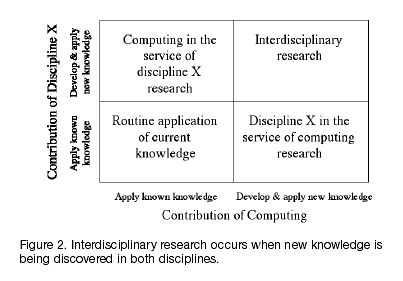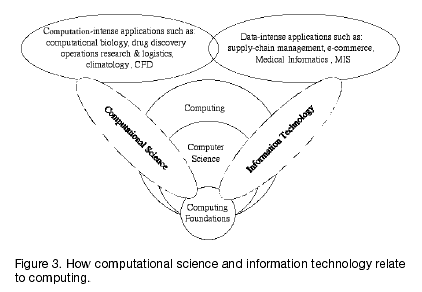THIS IS AN ARCHIVED VERSION OF CRA'S WEBSITE. THIS ARCHIVE IS AVAILABLE TO PROVIDE HISTORICAL CONTENT.
PLEASE VISIT HTTP://WWW.CRA.ORG FOR THE LATEST INFORMATION
| About CRA |
| Membership |
| CRA for Students |
| CRA for Faculty |
| CRA-Women |
| Computing Community Consortium (CCC) |
| Awards |
| Projects |
| Events |
| Jobs |
| Government Affairs |
| Computing Research Policy Blog |
| Publications |
| Data & Resources |
| CRA Bulletin |
| What's New |
| Contact |
| Home |
Back to September 2002 CRN Table of Contents
[Published originally in the September 2002 edition of Computing Research News, Vol. 14/No. 4, p. 6.]
Computing > Computer Science
By Jim Foley
Why are we called the Computing Research Association instead of the Computer Science Research Association?
Our Mission Statement records that:
"In 1986 CSB, in recognition of its increasing concern for R&D in the computing fields, including computer engineering and computational science, incorporated as the Computing Research Board (CRB). In 1990, CRB was given its present name …" .
The more general question is "What is computing and how does it differ, if at all, from computer science?" This of course depends on what we mean by computer science.
Abelson and Sussmann [1] write: "Computation provides a framework for dealing precisely with notions of 'how to.'" In a recent presentation, Sussmann [2] contrasts the "how to" of computer science with the "what is" of mathematics. I would go further. Science discovers the laws of nature--the "what is" of nature. Engineering uses the laws of nature to create physical artifacts. In contrast, computer science discovers and uses the laws of "how to" compute and "how to" organize information to create computational and information artifacts. Computer science is also concerned with the organization--that is, the architecture--of the physical artifacts that perform computations and that store and transmit information. (Computer science is both science and engineering--a good thing, in my opinion, but that's another story.)
What then of computing? It is simply computer science with an additional emphasis on understanding the ways and domains in which computers are used, and the ways in which computational engines are engineered. Also, because people are the users of much of our computer technology, understanding people is important to computing. The more engaged one becomes with application domains and human issues in doing computer science research, the more one is doing computing research in addition to computer science research. So it is a continuum. There is no hard dividing line.
I've been at Georgia Tech's College of Computing for much of the time since I first moved south in 1991. Our strategic plan says: "The College was founded to focus on computing - the integration of computer science and other disciplines to address problems of wide interest. Our interest in end-results leads immediately to our concentration on the human element of computing in much of our research and to our aggressive interdisciplinary orientation."
Computing is concerned both with deep theoretical questions about the nature of computing and information, as well as with new and creative ways to use computers to solve problems. That is, computing simultaneously looks inward to solve fundamental problems, and looks outward to solve real-world problems and to work collaboratively with other disciplines to solve problems that neither computer science nor the other discipline alone could solve. Indeed, in some cases they are problems that neither discipline could even recognize without collaborating, and in some cases the collaboration leads to fundamentally new ways of thinking about problems.
I used figure 1 at our Snowbird meeting to suggest that:
- Computing contains computer science.
- Computing foundations are partially within computer science and computing and partially outside computer science and computing, drawing on disciplines such as math, probability, statistics, philosophy, linguistics, semantics, cognitive science, library science, and cryptography.
- Working on research challenges coming from application domains is an important aspect of computing. Again, there is a continuum.

"Interdisciplinary research" means different things to different people. Figure 2 captures some possible interpretations--or misinterpretations. It is only in the upper-right quadrant that I consider true interdisciplinary research to be occurring. Yes, sometimes a research team will start in one of the other quadrants as a "get acquainted with the problem domain" strategy, but the target must also be the upper-right quadrant!

What about the relationship between computing and information technology? Figure 3 shows two types of application domains--those that are computing-intense and those that are data-intense (the two overlap because there is a continuum here as well). The intersection between computing-intense applications and computing is computational science and the intersection between data-intense applications and computing is information technology. Again, each of computational science and information technology can involve research in computing foundations, computer science, and computing.

CRA's goal is to have as members and provide service to all groups that are doing computing research, whether it be in traditional computer science, computer engineering, computational science, information technology, information science, computational biology, medical informatics, or any domain in which new computing knowledge is being created
My understanding and articulation of the structure of the discipline of computing is still evolving. I welcome your feedback (foley@cc.gatech.edu).
Jim Foley is chair of the CRA board.
References:
[1] Abelson and Sussmann, Structure and Interpretation of Computer Programs, MIT Press, Cambridge, MA, 1985.
[2] Sussmann, G, The Legacy of Computer Science, presentation at NRC/CSTB Symposium Fundamentals of Computer Science, http://www7.nationalacademies.org/cstb/project_fcs_agenda3.html
Copyright © 2007 Computing Research Association. All Rights Reserved. Questions? E-mail: webmaster@cra.org.
